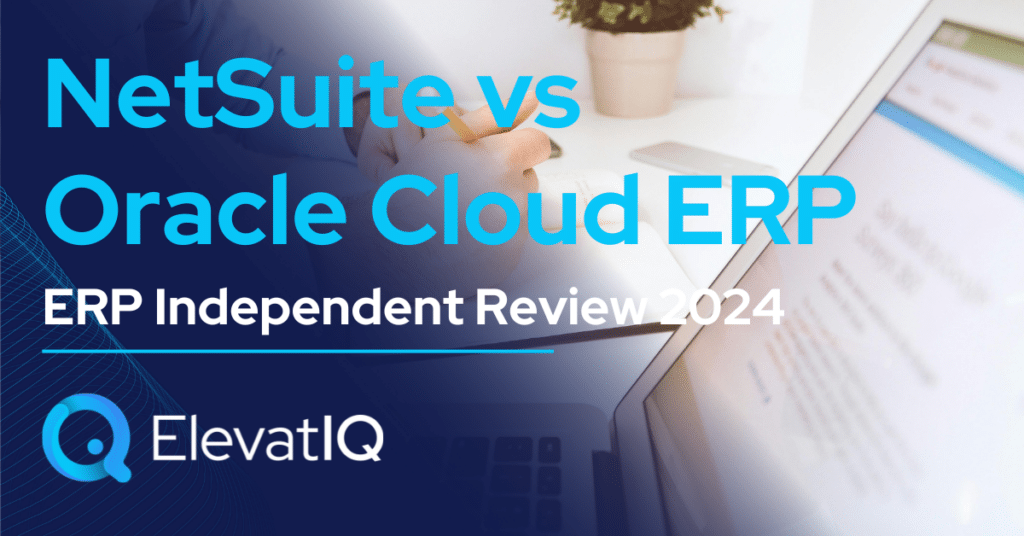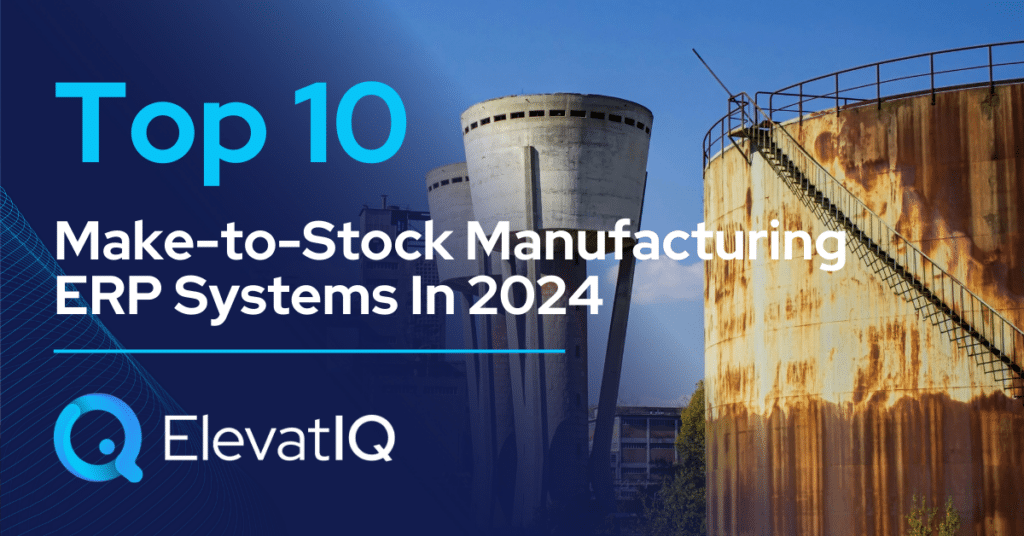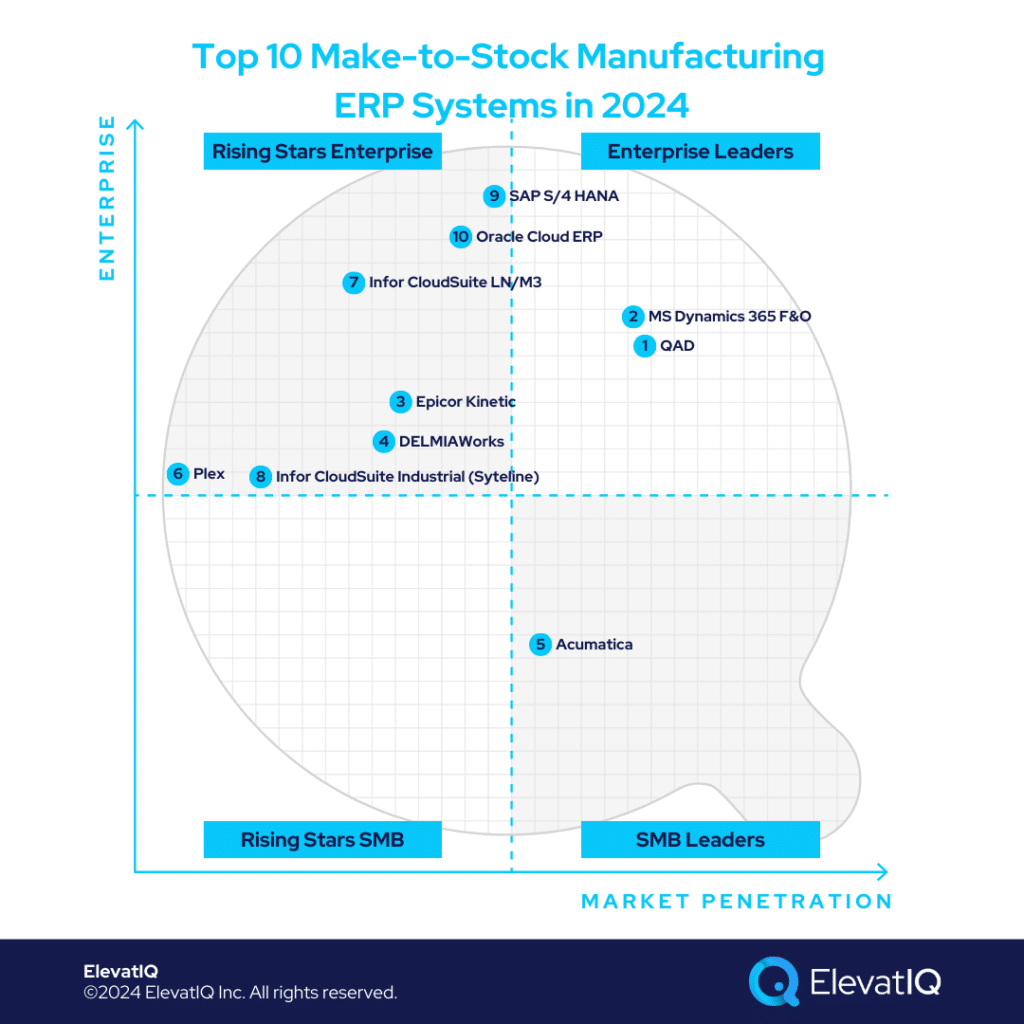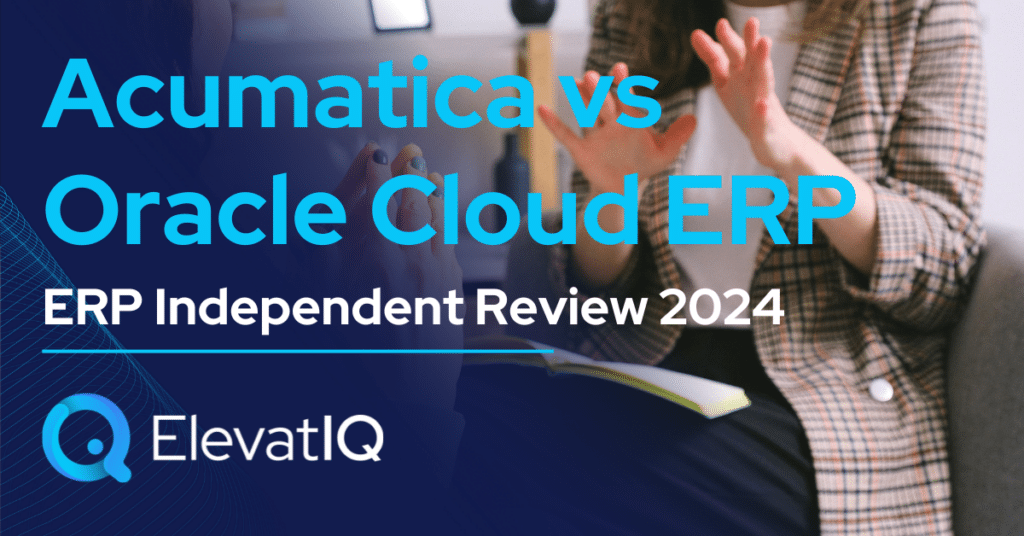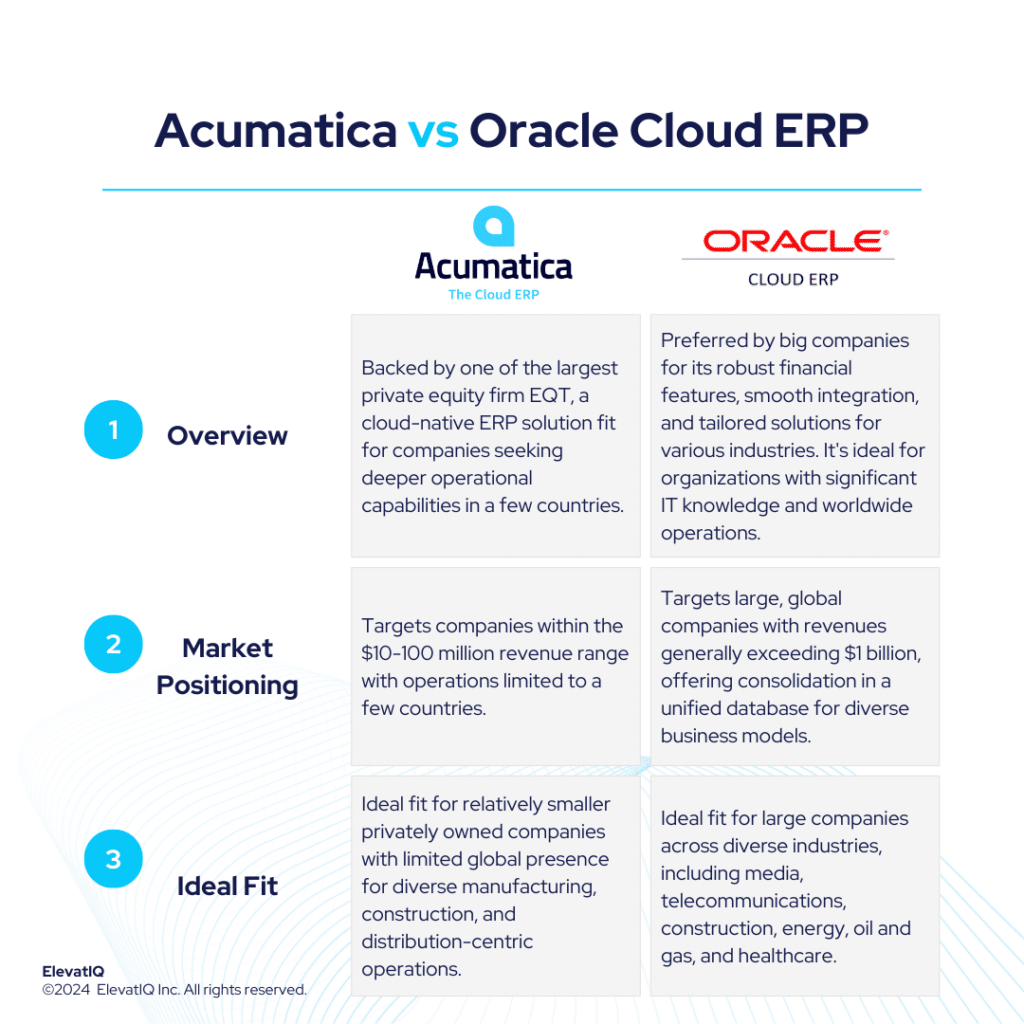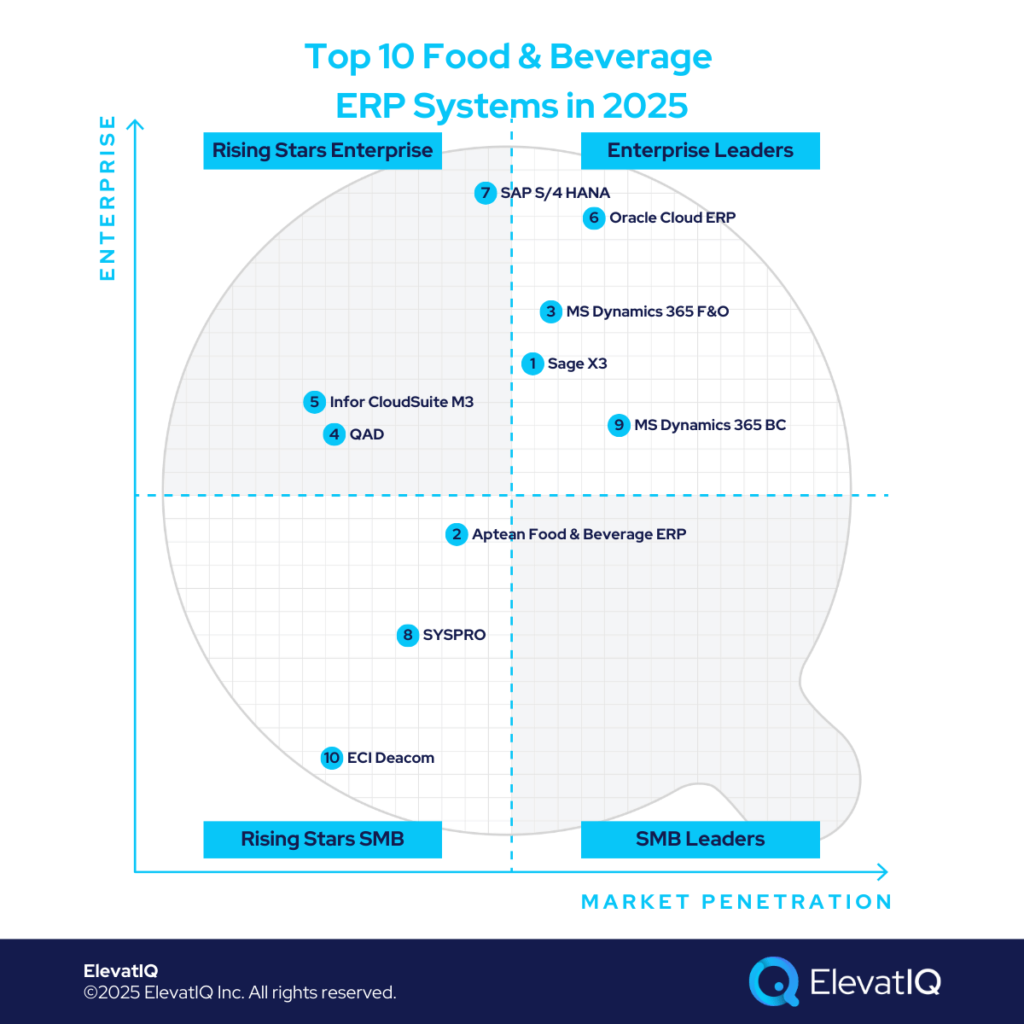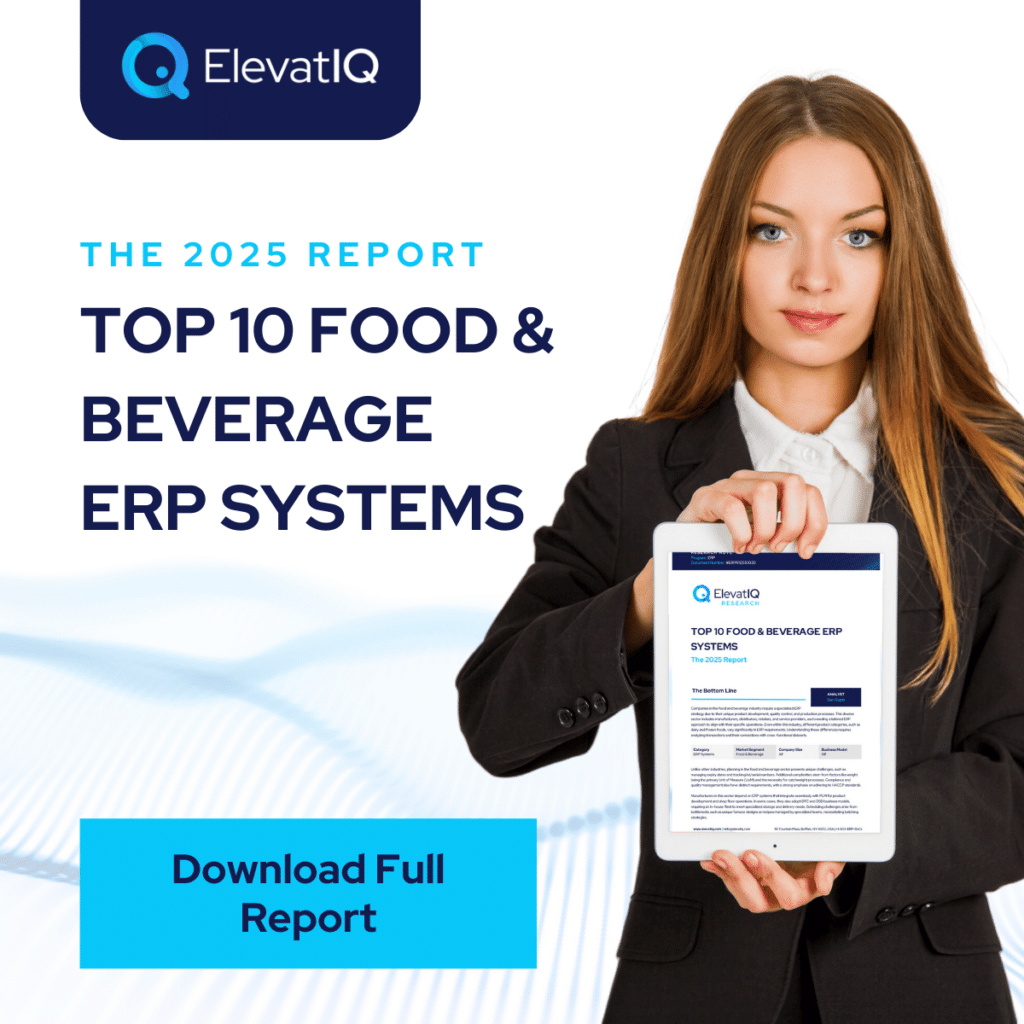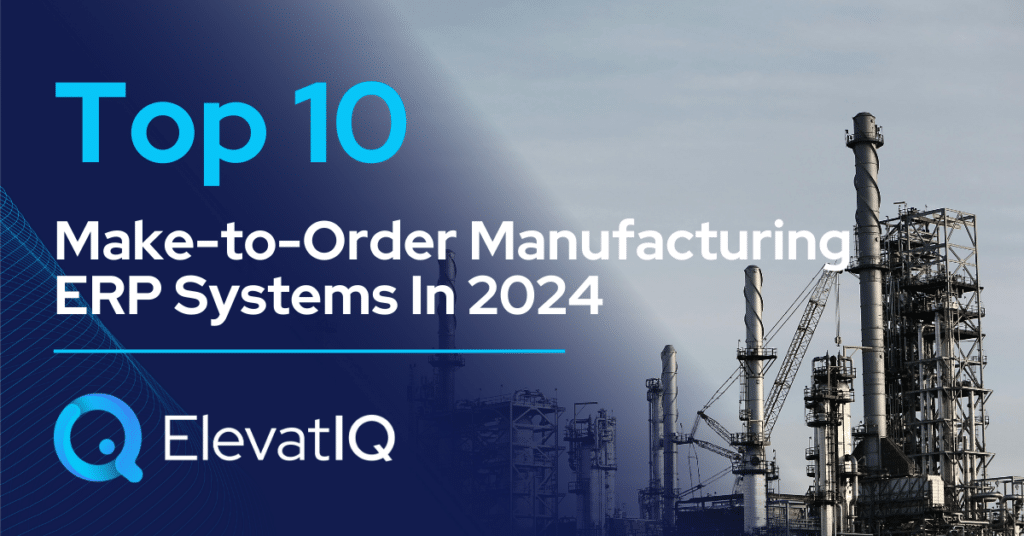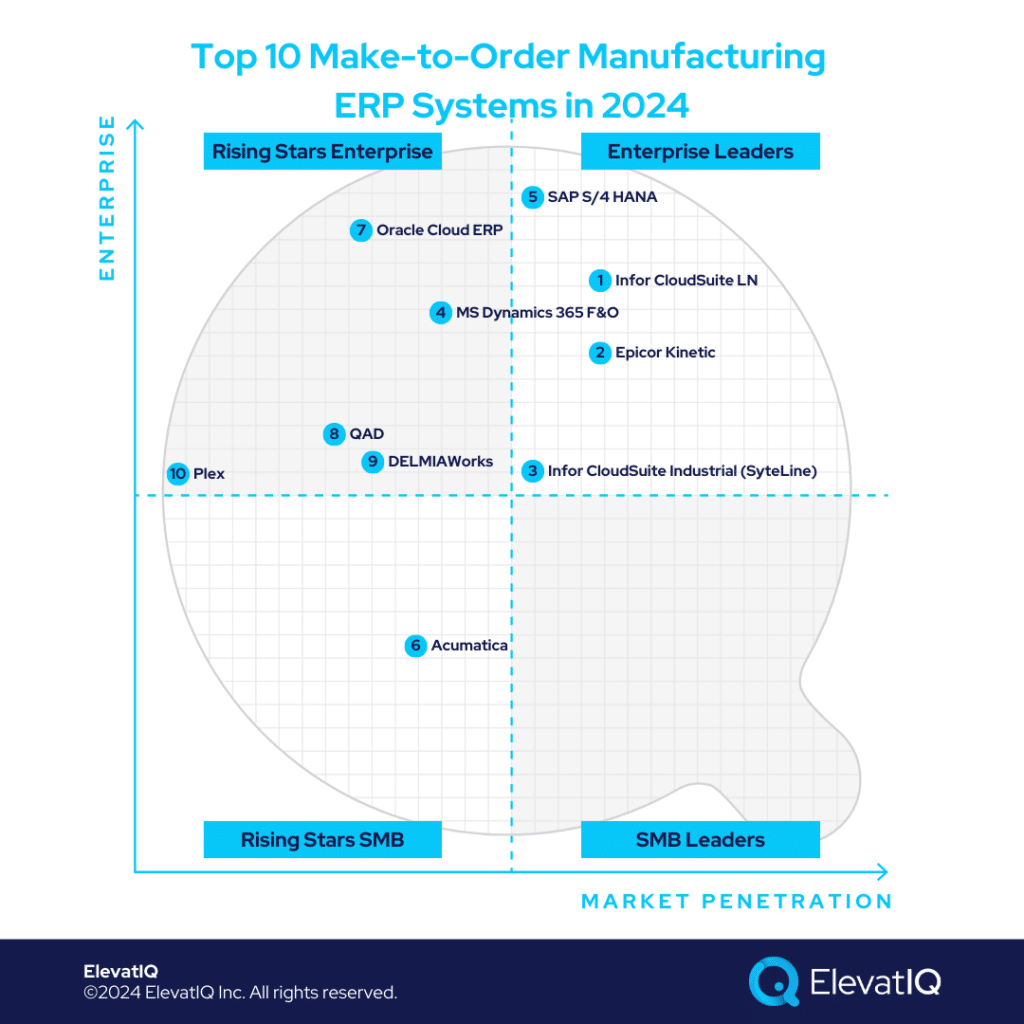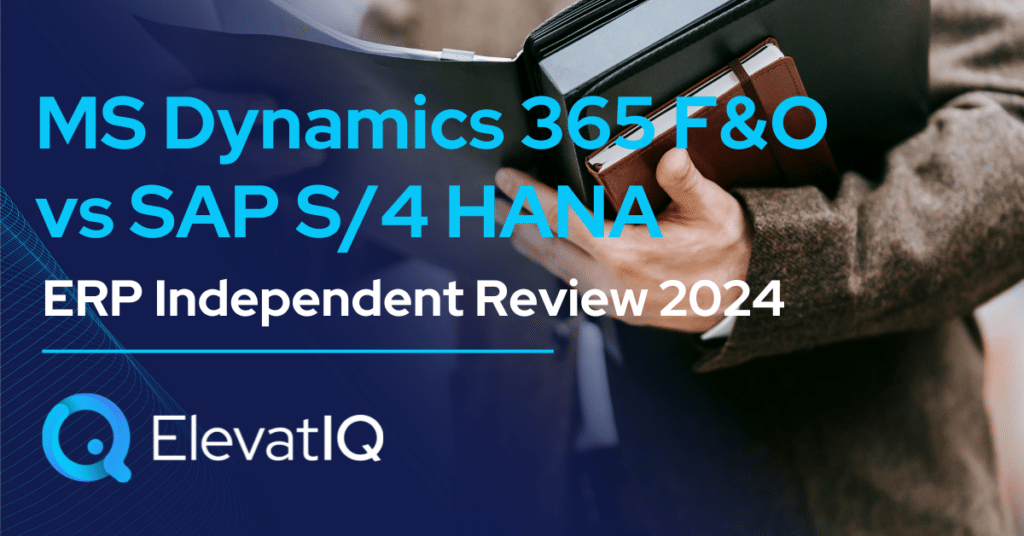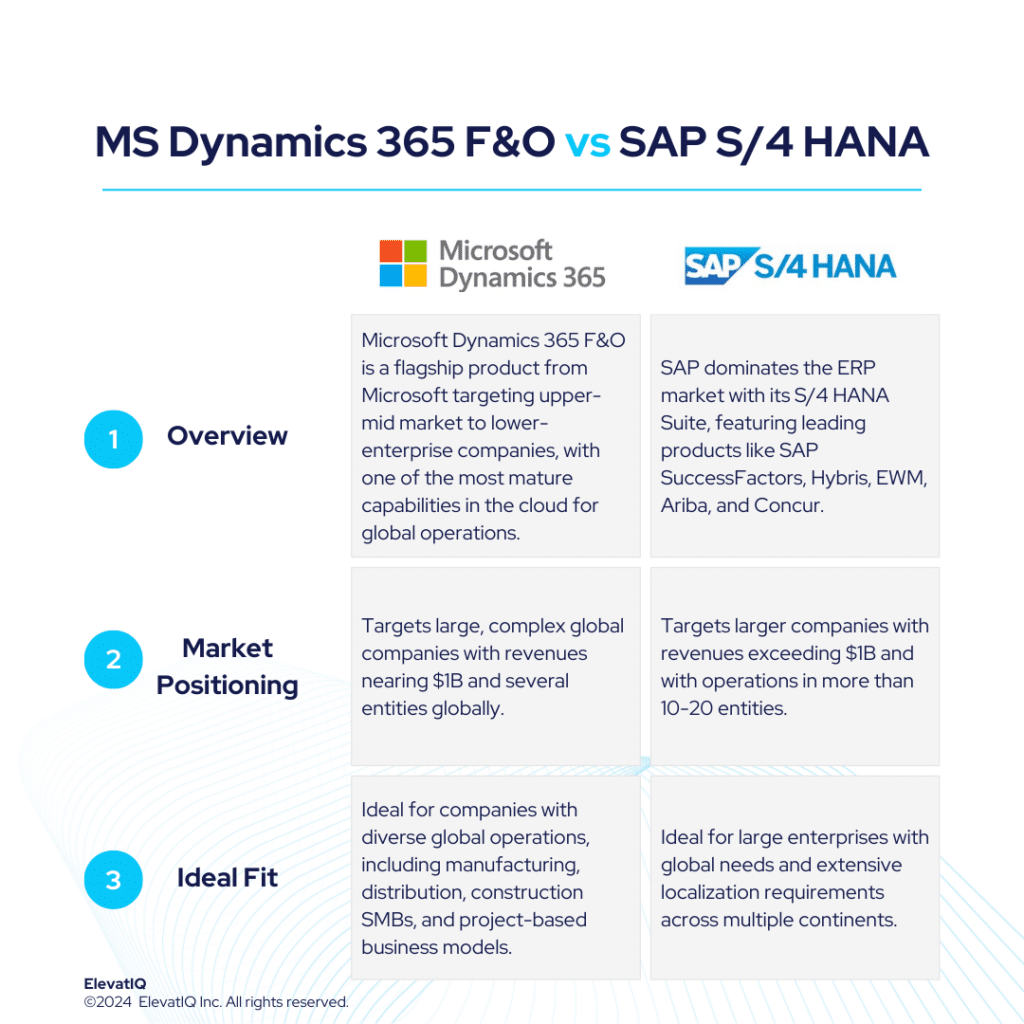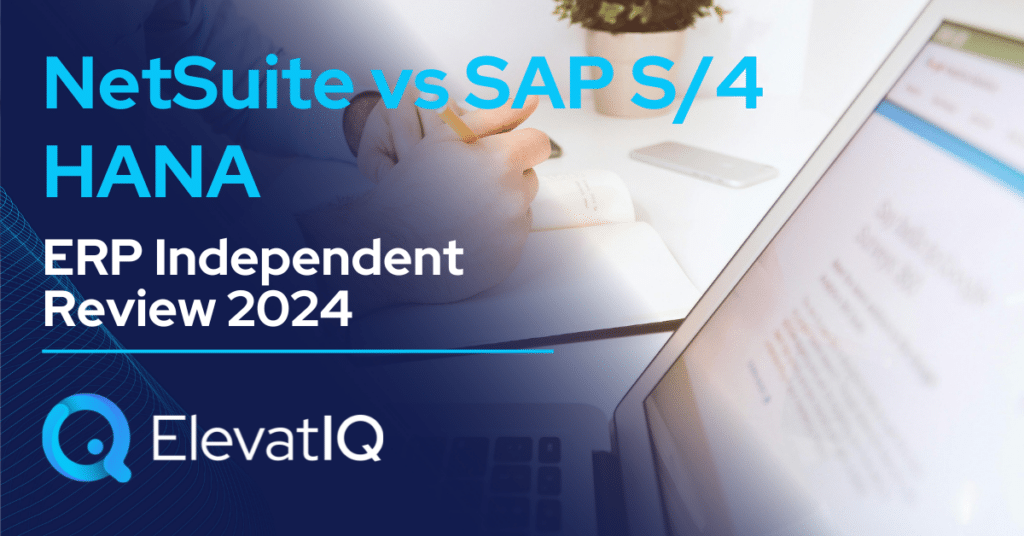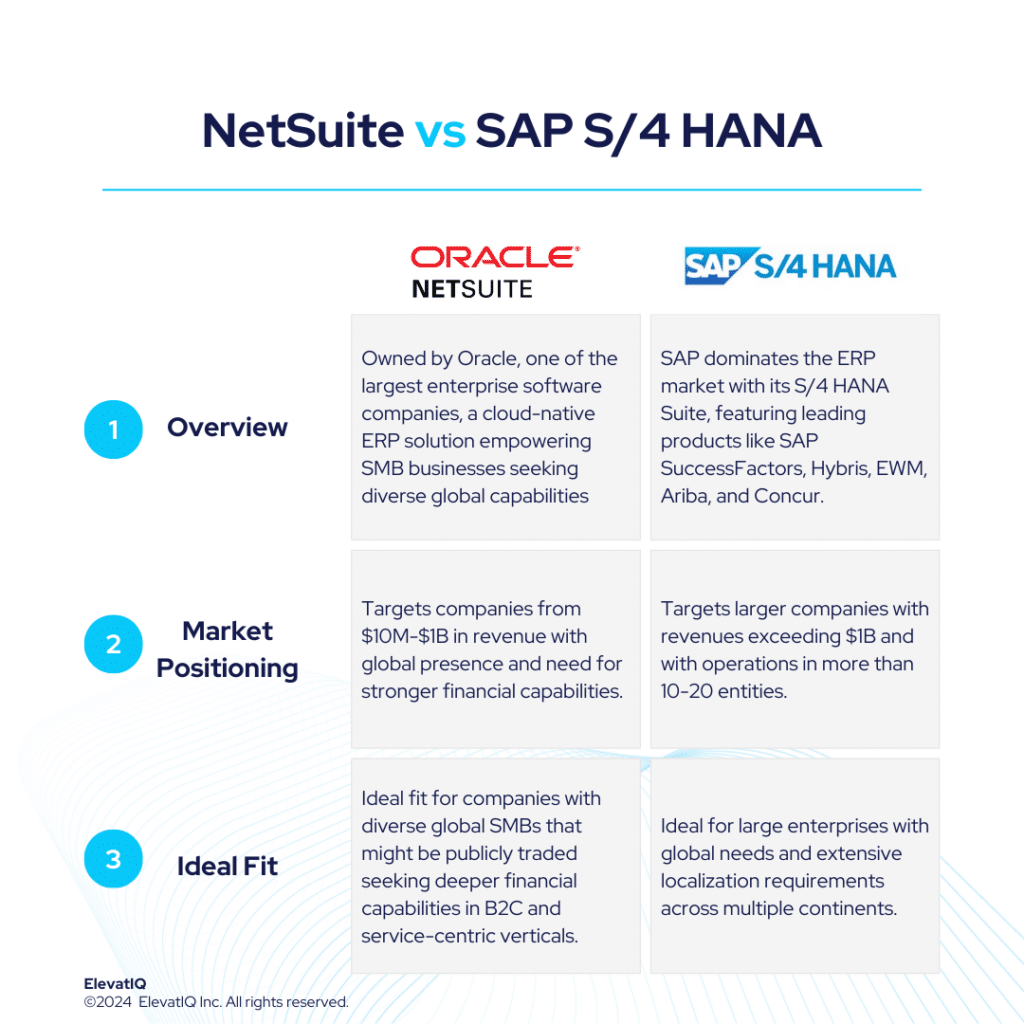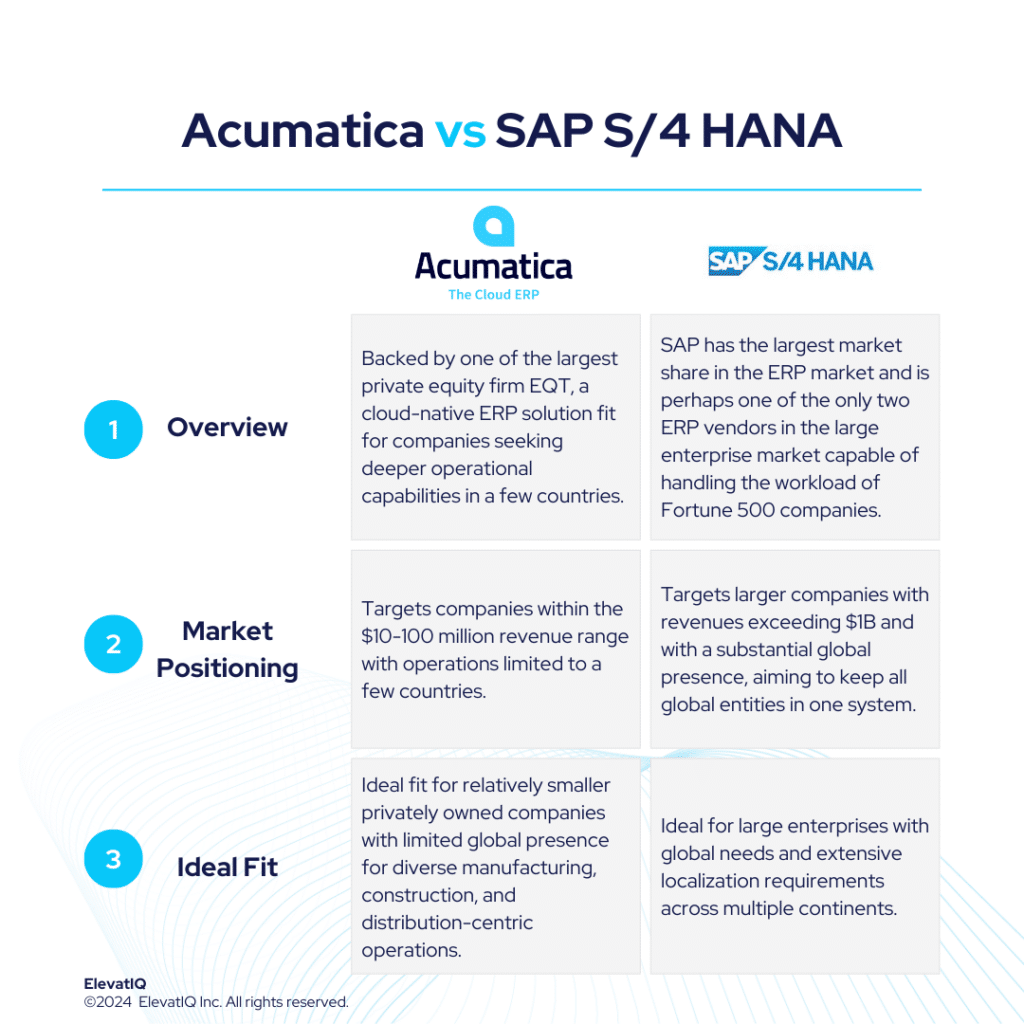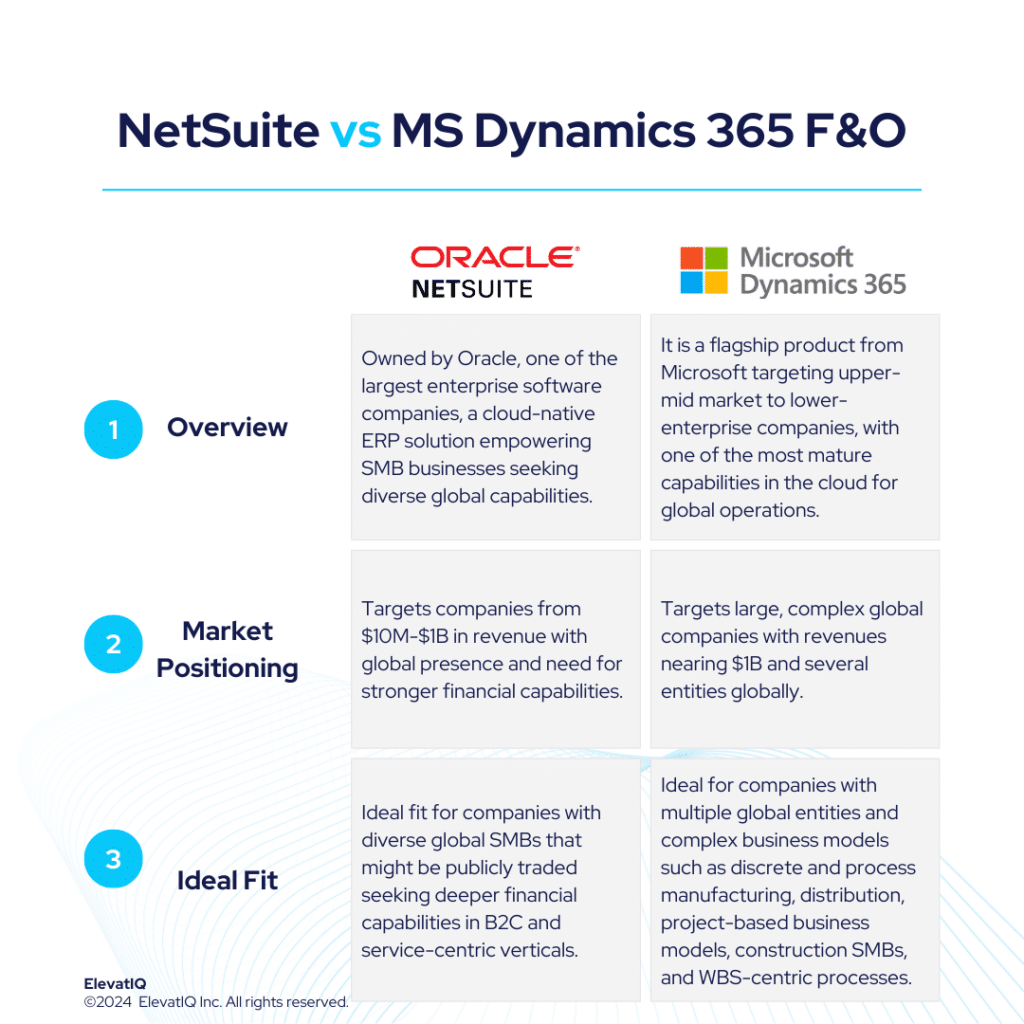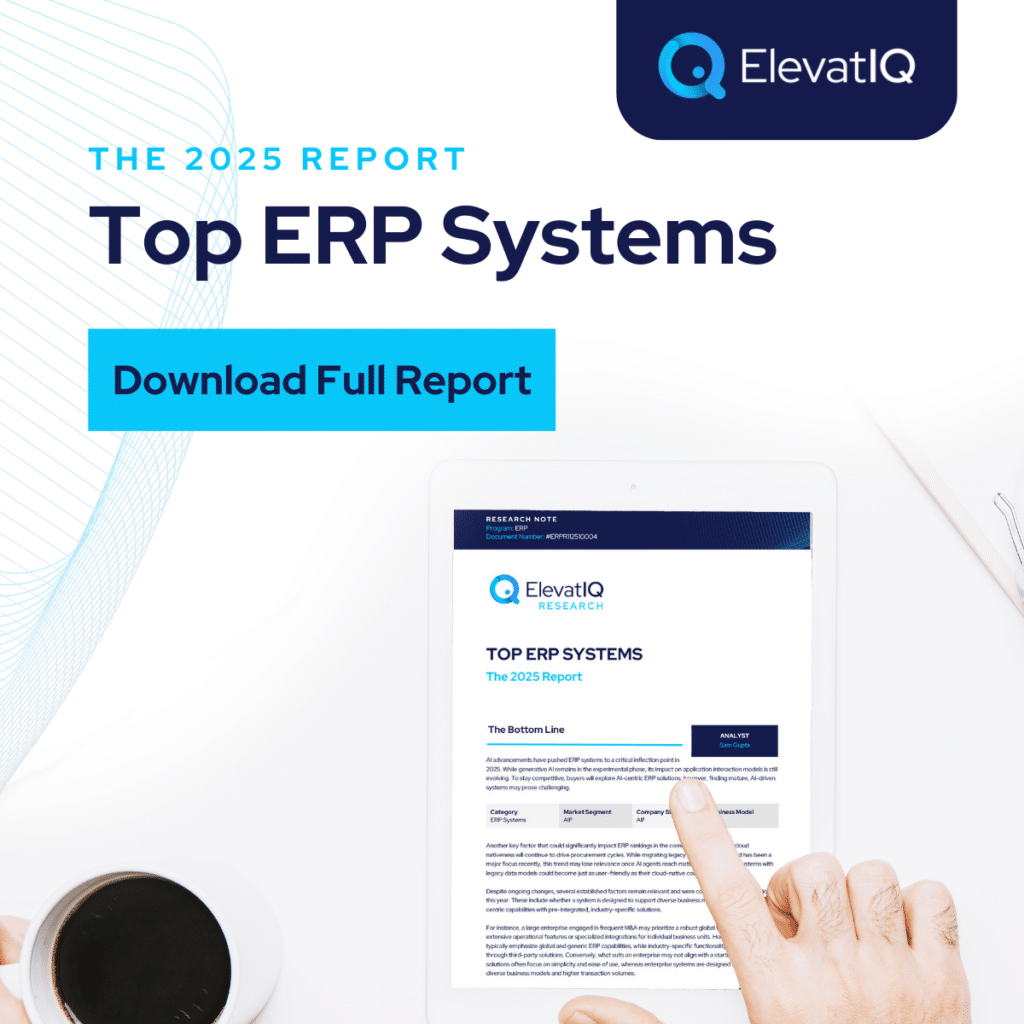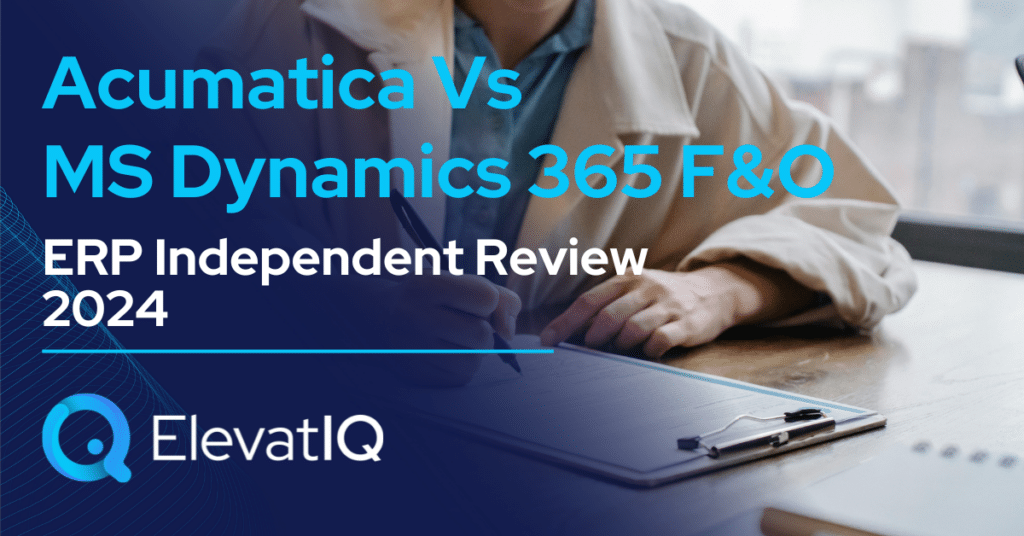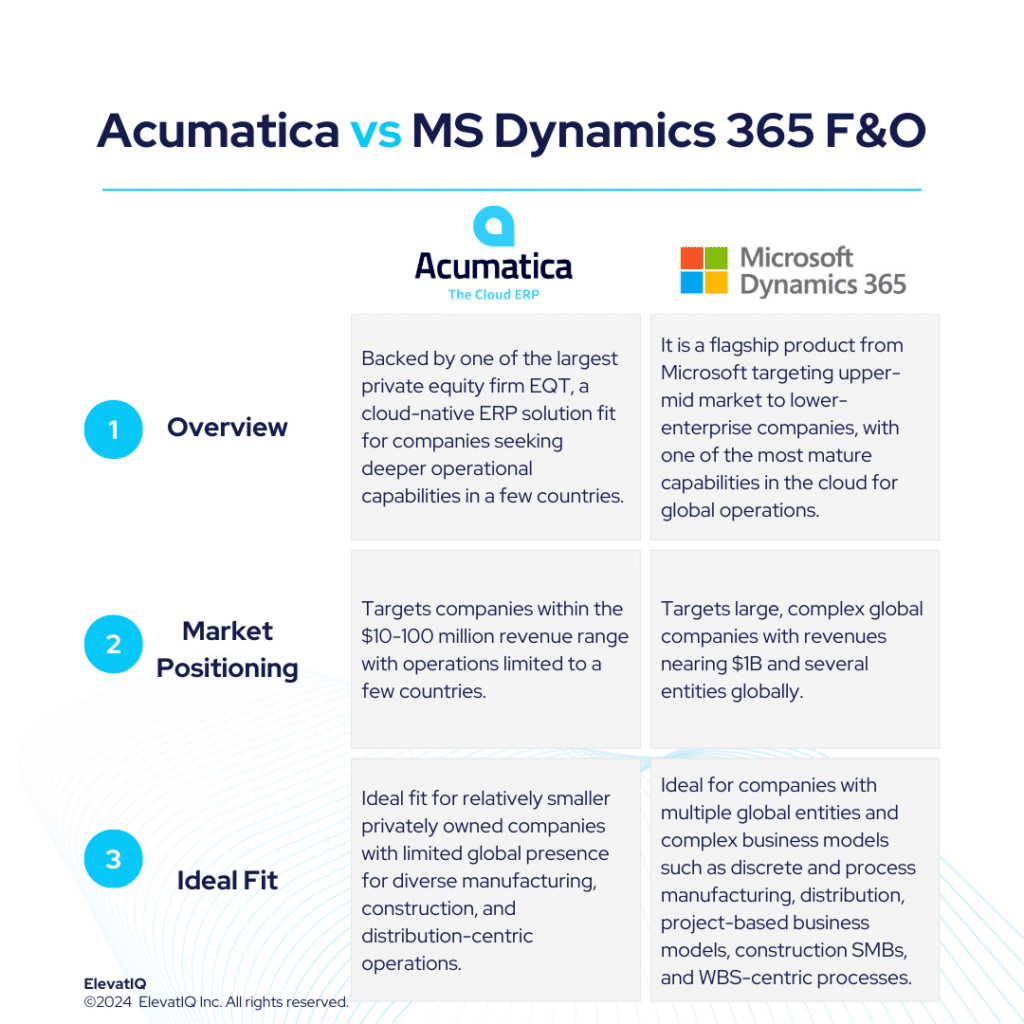NetSuite vs Oracle Cloud ERP Independent Review 2024
NetSuite caters well to globally spread small to mid-market companies seeking robust financial capabilities with localization in numerous countries. It offers solutions tailored to specific business models. On the other hand, Oracle ERP Cloud remains a top choice for large companies across diverse industries, particularly media, telecommunications, construction, energy, oil and gas, and healthcare. Despite the need for internal IT expertise, it is also suitable for companies with a need to integrate various third-party software systems.
NetSuite is suitable for a diverse range of companies, particularly service-centric, distribution-centric, commerce-centric, and B2C organizations. Whereas, Oracle Cloud ERP particularly caters to companies needing ledger-level security and hierarchical financial reporting. Additionally, Oracle Cloud ERP seamlessly integrates a powerful HCM solution along with a natively integrated EPM solution. On the other hand, NetSuite performs well across various industries but may lack depth for industrial distributors and manufacturers, focusing more on lighter manufacturing and consumerized products like health and beauty, fashion, apparel, and CPG. So, if you have narrowed down your choices between NetSuite vs Oracle Cloud ERP, this comparison looks under the hood and provides crucial information for your ERP selection project. So, let’s dive in?
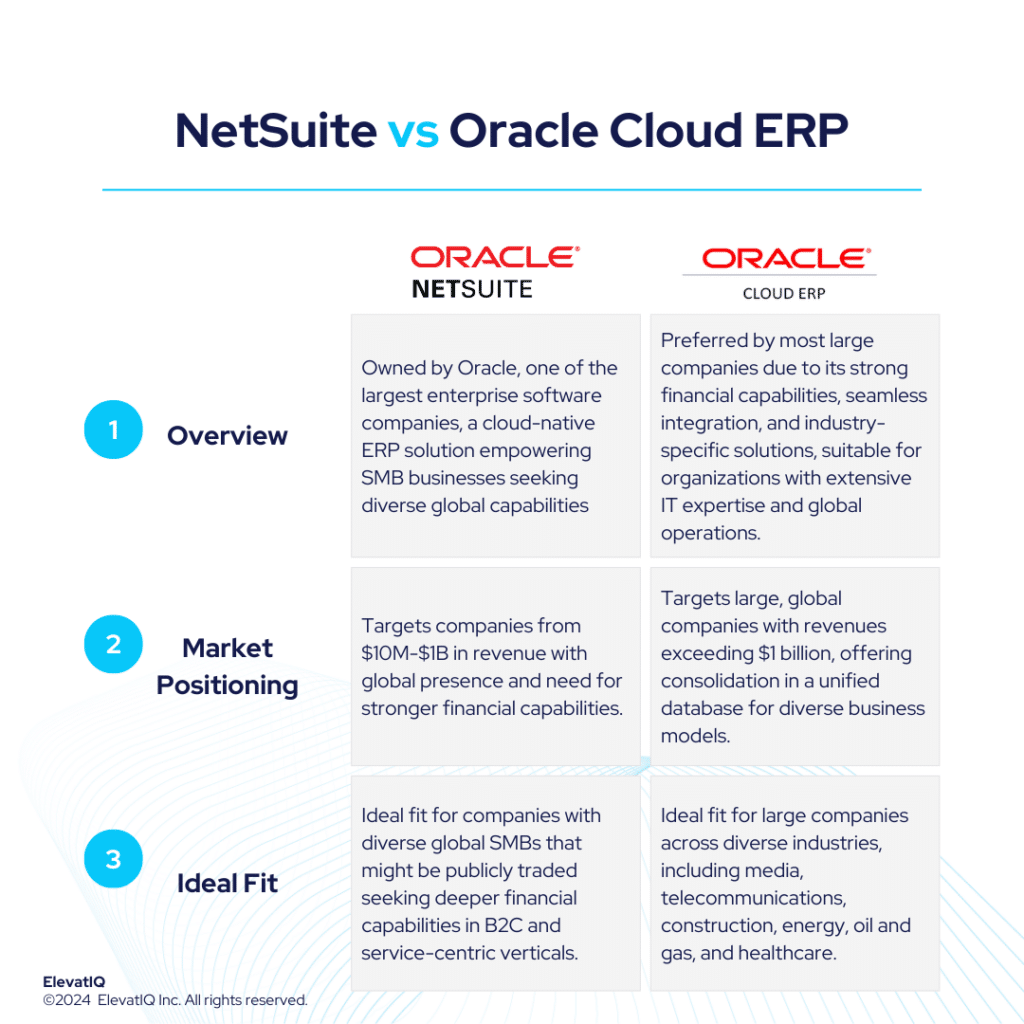

| NetSuite | Oracle Cloud ERP | |
| Started in | 1998 | 2012 |
| Ownership by | Oracle | Oracle |
| No. of customers | 37,000+ | 10,000+ |
What is NetSuite?
NetSuite stands out as the leading ERP solution, driven by its success for diverse industries particularly seeking stronger financial capabilities over the operational, robust ecosystem, credible marketplace add-ons, and comprehensive functionality. Not as complex as some competitors like SAP S/4 HANA and Microsoft F&O, NetSuite also excels in supporting diverse business models, including omnichannel architecture, matrix/dimensional inventory, and subscription-based models.
While NetSuite excels across industries, it may not be the ideal choice for industrial distributors and manufacturers due to limitations in pricing and item master capabilities. Its strength particularly lies in supporting lighter manufacturing and consumerized products like health and beauty, fashion, apparel, and CPG. With robust financial capabilities and an integrated HCM solution, NetSuite is well-suited for service-centric industries, including smaller banks, credit unions, financial services, non-profit organizations, as well as the technology and media sectors. While NetSuite remains the top-ranked solution due to its product quality, there might be challenges with over-customization and integration issues, leading to ERP implementation failures. Therefore, working with NetSuite demands thorough vetting of their solution and architecture.
What Is Oracle Cloud ERP?
Oracle ERP Cloud remains a top choice for large companies across diverse industries, particularly media, telecommunications, construction, energy, oil and gas, and healthcare (post-acquisition of Cerner). It is particularly suitable for organizations with substantial internal IT expertise and a requirement for integrating various proprietary and third-party ERP add-ons, such as patient claims management or utility billing solutions.
Oracle ERP Cloud is well-suited for global companies who are looking for an ERP system to use as their corporate financial ledger while employing other systems at the subsidiary level. Its robust financial capabilities cater to companies needing ledger-level security and hierarchical financial reporting, such as LOB, functions, or funds. Additionally, it seamlessly integrates a powerful HCM solution along with a natively integrated EPM solution.
Oracle ERP Cloud excels in risk management, advertising, and Cx cloud, particularly catering to industries like financial services and insurance. While it is a superior fit for service-centric industries, its success in product-centric industries has been limited. Often used as a corporate ledger, it might deploy another operationally rich solution at the subsidiary level in certain industries. Despite its strength for large enterprises, Oracle ERP Cloud is not the ideal choice for SMB customers.
NetSuite vs Oracle Cloud ERP Comparison
Navigating the choice between NetSuite vs Oracle Cloud ERP is a significant decision for businesses particularly looking for operational efficiency and strategic alignment. Thus, this section delves into the comprehensive comparison of NetSuite vs Oracle Cloud ERP across various critical dimensions.
| NetSuite | Oracle Cloud ERP | |
| Global Operational Capabilities | Natively localized in over 100 countries. | Has enterprise-grade multi-entity capabilities for global organizations. |
| Diverse Capabilities | Supports diverse business models across multiple countries, but operational richness might not be as extensive. | Has the ability to support diverse business models, but last mile industry-specific capabilities might rely on third-party add-ons. |
| Best-of-breed Capabilities | Contains pre-integrated components like HCM and FP&A, though the maturity of these components may vary. | Comprehensive enterprise-grade best-of-breed options as part of the suite, including HCM, CPQ, WMS, RMS, and TMS. |
| Last-mile Capabilities | Limited last-mile capabilities for industries like manufacturing, necessitating add-ons. | Limited last-mile capabilities might require add-ons or custom development. |
| Integration Capabilities | Has an integrated FP&A and relies on Celigo to integrate with marketplace offerings. | Enterprise-grade integration suite capabilities with pre-integrated components. |
| Manufacturing Capabilities | Limited manufacturing capabilities primarily limited to assembly-centric operations. | Companies using it in the best-of-breed architecture with a focused manufacturing solution at the subsidiary level would find the most value with it. |
| Pricing Model | Named-user based | Named-user based |
| Key Modules | 1. Financial Management 2. Accounting 3. Global Business Management 4. Inventory Management 5. Order Management 6. Supply Chain Management 7. Warehouse Management 8. Procurement 9. CRM | 1. Financial Management 2. Project Management 3. Procurement 4. Risk Management and Compliance 5. Enterprise Performance Management 6. Supply Chain and Manufacturing 7. ERP Analytics |
NetSuite vs Oracle Cloud ERP Feature Comparison
Both platforms offer a plethora of features and functionalities designed to streamline business operations and enhance efficiency. In this feature comparison, we delve into particularly the distinct capabilities of NetSuite vs Oracle Cloud ERP across various critical dimensions, providing insights to aid businesses in making informed decisions regarding their ERP selection. Thus, this section discusses features under each of the following modules, particularly financial management and, supply chain management.
Financial Management Comparison
In this section, we are discussing a detailed comparison of the financial management capabilities particularly offered by NetSuite vs Oracle Cloud ERP. By examining their respective strengths and functionalities, particularly in managing financial processes. Businesses can therefore gain valuable insights to determine the best-suited ERP solution for their financial management needs.
| NetSuite | Oracle Cloud ERP | ||
| Financial Management | General Ledger | Supports complex general ledgers, including public reporting requirements of several countries but primarily for SMB companies under $1B in revenue. | Enterprise-grade ledgers to support multi-country operations at the global level with layers of sub-ledgers and complex closing process. |
| Accounts Receivable and Accounts Payable | Automates and streamlines invoice delivery, payment processing, and collections management as well as accounts payable processes. | Support for complex, global AR and AP processes, including shared services. | |
| Cash Flow Management | Provides visibility to optimize cash flows, monitor bank accounts, and manage liquidity. | Enterprise-grade capabilities for cash and treasury management. | |
| Tax Management | Manages domestic and global tax, generates detailed reports, and analyzes transactions real-time. | Global and enterprise-grade tax management capabilities, with support for most countries in the world. |
Supply Chain Management Comparison
In this comparison, we explore and analyze the supply chain management capabilities of NetSuite vs Oracle Cloud ERP, shedding light particularly on their respective strengths and weaknesses.
| NetSuite | Oracle Cloud ERP | ||
| Supply Chain Management | Warehouse Management | Provides the ability to optimize day-to-day warehouse operations, eliminate manual processes and minimize handling costs. | Streamlines warehouse operations, enhances inventory management and ensures seamless multichannel fulfillment, end-to-end inventory visibility, and integration with advanced features for efficient resource allocation and workflow optimization. |
| Procurement | Allows purchasing departments to prepare and send out purchase orders, track them as they transform into sales orders, and automatically update inventory levels upon order fulfillment | An integrated source-to-settle suite that automates business processes, enables strategic sourcing, improves supplier relationship management, and simplifies buying, resulting in lower risk, improved savings, and greater profitability. | |
| Inventory Management | Automates inventory management processes with multi-location fulfillment, cycle counting, replenishment, traceability, and item visibility. | Enables efficient management of goods flow, including inbound, within the warehouse, and outbound, while also supporting consigned inventory capabilities. |
Pros of NetSuite vs Oracle Cloud ERP
When evaluating ERP solutions, understanding the distinct advantages of NetSuite vs Oracle Cloud ERP is crucial. In this section, we are particularly exploring the strengths of NetSuite vs Oracle Cloud ERP across various dimensions. Thus, shedding light on their respective capabilities and functionalities.
| NetSuite | Oracle Cloud ERP |
| Provides richer financial capabilities over operational, with leaner operational layers. | The product architecture supports the needs of large, complex financial organizations with deep sub-ledger hierarchies. |
| Ideal for SMBs operating in different countries. | Oracle Cloud ERP has an ecosystem of experienced consultants capable of handling the architecture of such complex enterprises. |
| The data model is B2C friendly, supporting integration with B2C channels. | The embedded HCM and CRM processes are suitable for large non-profit organizations. The P2P workflows are friendlier for the indirect procurement needs of non-profit organizations. |
| Ideal for eCommerce-centric SMBs because of the ecosystem and the integration operations available for eCommerce-centric companies. | Oracle Cloud ERP is designed to process millions of GL entries per hour. |
Cons of NetSuite vs Oracle Cloud ERP
Just like recognizing strengths is important, it’s also crucial to weigh the specific drawbacks of Acumatica vs Oracle Cloud ERP. Therefore, in this section, we will delve into the limitations and challenges associated with NetSuite vs Oracle Cloud ERP across various operational and financial dimensions.
| NetSuite | Oracle Cloud ERP |
| Not a great value for companies operating only in a few countries as they can get richer operational capabilities. | While functionally capable, transactional and financial traceability might not be as intuitive for large, complex enterprises. |
| May struggle with transactional workload requirements of companies over $1B and the ones that might be acquiring 10-20 entities every year. | The data model is overwhelming for smaller organizations outgrowing QuickBooks or smaller ERP systems. |
| Not ideal for startups as they might find audit-centric and deep financial capabilities over-bloated. | Might struggle with the complex MRP runs hitting millions and millions of costing, scheduling, and also WIP industries. |
| Named-user-based pricing requires allocating fixed costs, even for seasonal workers or external users accessing the subset of data such as customer or vendor portals. | Longer time in customizing and configuring as the software design may consist of unnecessary allocation, commitment, and approval functionality for large companies. |
| Not fit for companies seeking OEM-owned integration with core operational systems such as CAD or PLM. | The P2P processes, CPQ, and manufacturing capabilities may not be the friendliest for product-centric organizations particularly with the needs for MES, PLM, and S&OP-centric processes. |
| The last-mile capabilities required for manufacturing or industrial distribution are extremely limited. | Limited last-mile functionality for quality and compliance, which will require an add-on or custom development. |
Conclusion
In conclusion, when comparing NetSuite vs Oracle Cloud ERP, it becomes evident that both platforms offer distinct advantages tailored to different business needs. NetSuite excels in providing robust financial capabilities and tailored solutions for small to mid-market companies operating across multiple countries, making it a compelling choice for organizations seeking operational efficiency and flexibility.
On the other hand, Oracle Cloud ERP stands out as the preferred solution for large enterprises with extensive IT expertise and global operations, offering strong financial capabilities, seamless integration, and specialized solutions designed to meet the complex requirements of diverse industries. Ultimately, the decision between NetSuite and Oracle Cloud ERP hinges on factors such as company size, industry focus, and specific operational needs, highlighting the importance of carefully evaluating these factors to choose the ERP solution that best aligns with the organization’s goals and objectives.
While NetSuite may appeal to SMBs looking for a comprehensive yet user-friendly ERP system, Oracle Cloud ERP caters to the needs of large enterprises requiring advanced financial capabilities, industry-specific solutions, and seamless integration with existing systems. Despite their differences, both platforms aim to empower businesses to streamline operations, enhance productivity, and drive growth in an increasingly competitive landscape. Thus, by understanding the unique strengths and limitations of each platform, organizations can make informed decisions to select the ERP solution that best suits their requirements. Additionally, seeking assistance from independent ERP consultants can further aid in navigating the complexities of ERP selection, ensuring optimal outcomes for businesses in today’s dynamic market landscape.

FAQs
NetSuite vs Oracle Cloud ERP Independent Review 2024 Read More »

